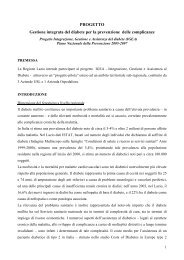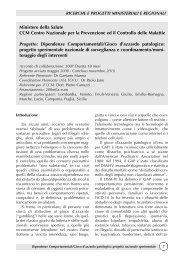Gaining health : analysis of policy development in European ...
Gaining health : analysis of policy development in European ...
Gaining health : analysis of policy development in European ...
You also want an ePaper? Increase the reach of your titles
YUMPU automatically turns print PDFs into web optimized ePapers that Google loves.
Ireland<br />
Anna Ritsatakis<br />
1. Country pr<strong>of</strong>ile<br />
Ireland lies <strong>in</strong> the Atlantic Ocean, separated from Great<br />
Brita<strong>in</strong> by the Irish Sea. The President is head <strong>of</strong> state, with<br />
a largely consultative role. Local government is composed<br />
<strong>of</strong> 29 county councils, 5 county borough corporations, 5<br />
borough corporations and some smaller entities.<br />
In 1973, Ireland jo<strong>in</strong>ed the EU. Irish is the first <strong>of</strong>ficial language<br />
and English the second.<br />
1.1. Socioeconomic <strong>development</strong><br />
Enter<strong>in</strong>g the 1980s with high <strong>in</strong>flation, substantial external<br />
debt and deteriorat<strong>in</strong>g public f<strong>in</strong>ances (1), this small open<br />
economy achieved a remarkable turnaround <strong>in</strong> the follow<strong>in</strong>g<br />
decade. Unemployment dropped from around 18% <strong>in</strong><br />
the late 1980s to 4.4% <strong>in</strong> 2005, half the average rate for<br />
the EU countries prior to 2004. GNP per capita rose from<br />
US$ 18 230 <strong>in</strong> 1980 to US$ 26 960 <strong>in</strong> 2003.<br />
Ireland’s economy is now one <strong>of</strong> the world’s most globalized<br />
and has experienced annual growth rates above the<br />
averages for developed countries. Growth rates averag<strong>in</strong>g<br />
10% were experienced <strong>in</strong> the period 1997–2000, while current<br />
rates are <strong>of</strong> the order <strong>of</strong> 4–5%.<br />
1.2. The people and their <strong>health</strong><br />
The population <strong>of</strong> Ireland has <strong>in</strong>creased from 2.9 million <strong>in</strong><br />
1970 to 4.2 million. Some sources forecast an <strong>in</strong>crease to<br />
over 5 million <strong>in</strong> the next 10 years. With decreas<strong>in</strong>g fertility<br />
rates, the proportion <strong>of</strong> children aged 0–14 years <strong>in</strong> the<br />
population fell from 31.3% <strong>in</strong> 1970 to 20.7% <strong>in</strong> 2005. The<br />
proportion <strong>of</strong> people aged 65 years or more has rema<strong>in</strong>ed<br />
stable at around 11%, but the numbers <strong>of</strong> people liv<strong>in</strong>g to a<br />
very old age is expected to <strong>in</strong>crease rapidly and, given the<br />
widen<strong>in</strong>g gender gap <strong>in</strong> life expectancy, these will be ma<strong>in</strong>ly<br />
women.<br />
Life expectancy at birth <strong>in</strong>creased between 1970 and<br />
2005 from 68.5 to 77.3 for men and from 73.2 to 81.8 for<br />
women. Until about 2000, this was the result <strong>of</strong> a rather<br />
mixed picture. While the SDR for cerebrovascular disease<br />
dropped rapidly, by 2000 it was still above the EU average.<br />
Mortality from all cancers and particularly from lung cancer<br />
<strong>in</strong> males aged 0–64 years dropped substantially between<br />
1980 and 1990, but rema<strong>in</strong>ed above the EU average <strong>in</strong><br />
2000. S<strong>in</strong>ce then, death rates from these diseases have<br />
fallen below the average <strong>in</strong> pre-2004 EU countries.<br />
Improvements <strong>in</strong> death rates for diseases affect<strong>in</strong>g women<br />
have been less evident. The SDR for cancer <strong>of</strong> the cervix<br />
rema<strong>in</strong>s double the pre-2004 EU average (4.6 compared<br />
to 2.3 <strong>in</strong> 2004) and the mortality rate for breast cancer <strong>in</strong><br />
women also rema<strong>in</strong>s above the pre-2004 EU average (30.8<br />
compared to 25.7 <strong>in</strong> 2004).<br />
Deaths from selected alcohol- and smok<strong>in</strong>g-related causes<br />
dropped very significantly from 1980, though the latter<br />
rema<strong>in</strong>ed well above the EU average <strong>in</strong> 2004 (252.6 compared<br />
to 205.4 per 100 000 population).<br />
The All-Ireland Study on Mortality 1989–1998 (2) showed<br />
that there was a three-fold difference <strong>in</strong> SDRs between<br />
men <strong>in</strong> the lowest and highest socioeconomic groups dur<strong>in</strong>g<br />
this period. The strong impact <strong>of</strong> occupational class was<br />
evident for nearly all the major causes <strong>of</strong> death. While occupation<br />
is recorded on death certificates, mortality data are<br />
not rout<strong>in</strong>ely available by socioeconomic group and there<br />
are <strong>in</strong>adequacies <strong>in</strong> the available data. More recent data for<br />
2002, although not strictly comparable with the 1989–1998<br />
data, <strong>in</strong>dicate persistence <strong>in</strong> <strong>health</strong> <strong>in</strong>equalities, particularly<br />
<strong>in</strong> areas such as heart disease, cancer, accidents and <strong>in</strong>juries,<br />
and low birth weight.<br />
Chapter 4<br />
149<br />
Case studies: <strong>policy</strong> <strong>development</strong> <strong>in</strong> countries for tackl<strong>in</strong>g noncommunicable diseases

















